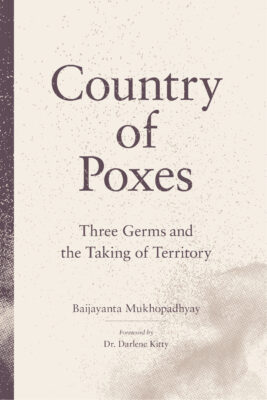What do syphilis or tuberculosis have in common with colonialism? Along with smallpox and many other infectious diseases, they caused the deaths of millions of Indigenous peoples, destroying cultures, societies and economies, and reducing their abilities to resist European colonization around the world.
In pre-contact Canada, according to the Canadian Encyclopedia, conservative estimates put the Indigenous population “between 350,000 and 500,000 people, with some estimates as high as two million.” Some say these estimates are much too low. Regardless, by 1867, “it is thought that between 100,000 and 125,000 First Nations people remained.” Settlers moved onto territories left behind by Indigenous nations decimated by waves of deadly disease, or removed people to Indian reserves and settlements controlled by Canadian laws and government officials.
Country of Poxes Fernwood Publishing
Three Germs and the Taking of Territory
Baijayanta Mukhopadhyay
$28.00
paper
264pp
9781773635545
This is a familiar story for the author, who writes that his own life and the history of his birth country, India, have been shaped by comparable colonial experiences.
It seems strange that this doctor, born in the heat of the desert and now working in the icebound village of the boreal forest, should be so engrossed in the stories of these particular diseases. But their historical arc puts into perspective the trajectory of epidemics I see now. They also help me understand my place in the world in significant ways. As someone who became unwittingly engaged in the project of Canada through immigration and adolescence, I think it my duty to undo my ignorance by critically examining the institutions in which I now participate.
By Confederation, Indigenous peoples were deemed a “dying race”and Canada created policies of assimilation to make this happen as efficiently as possible. Thus came the Indian Act, a reserve system, and residential schools across the country.
Infectious diseases didn’t cause any of the above but, the author writes, they played a role in making it possible. The story, though, doesn’t stop there. Mukhopadhyay states that these diseases have also shaped Canada’s Indigenous health policies until today.
In the past, paternalism, prejudice, and fear influenced how government officials and medical professionals treated Indigenous peoples. If they were dying, why not let nature take its course? There was also widespread fear that something such as what was then called “Indian tuberculosis” might infect white populations. Separation and isolation became central to Canadian Indigenous policies, including health policy.
Canada created a separate but unequal healthcare system mirroring the residential school system. It began with separate rooms and clinics, leading to a system of “Indian hospitals” and sanatoria, and finally to a parallel system of healthcare for Indigenous peoples.
This book begins with the COVID-19 pandemic and how it triggered fears of past epidemics in Indigenous communities. Mukhopadhyay concludes with hopes that medical professionals realize there’s ongoing colonialism in healthcare systems: “Whether I work in a village in Guinea or on the streets of Montreal, the theme is the same; trust needs to be continually rebuilt with a system that has emerged from a history of imposition and control. Those of us with the system need to take the responsibility of extending ourselves to demonstrate that we deserve such faith.”
Mukhopadhyay’s writing style may not appeal to everyone; a few medical terms had me begging Google for help. It’s a minor quibble, as this important book introduces a global perspective on Canadian colonialism, and adds a lot to the current discourse about systemic dis crimination in Canada’s – and Quebec’s – healthcare systems.mRb






0 Comments